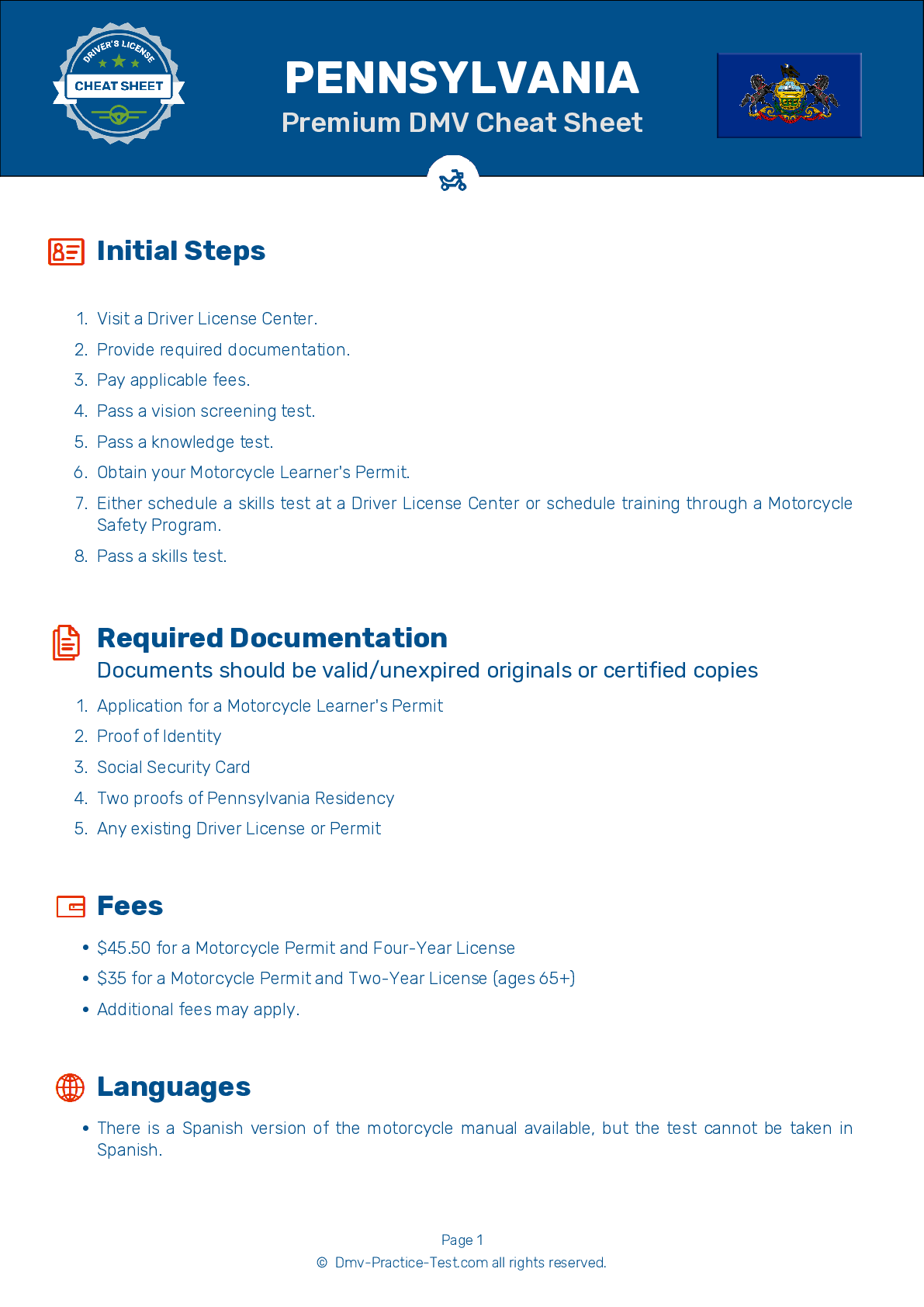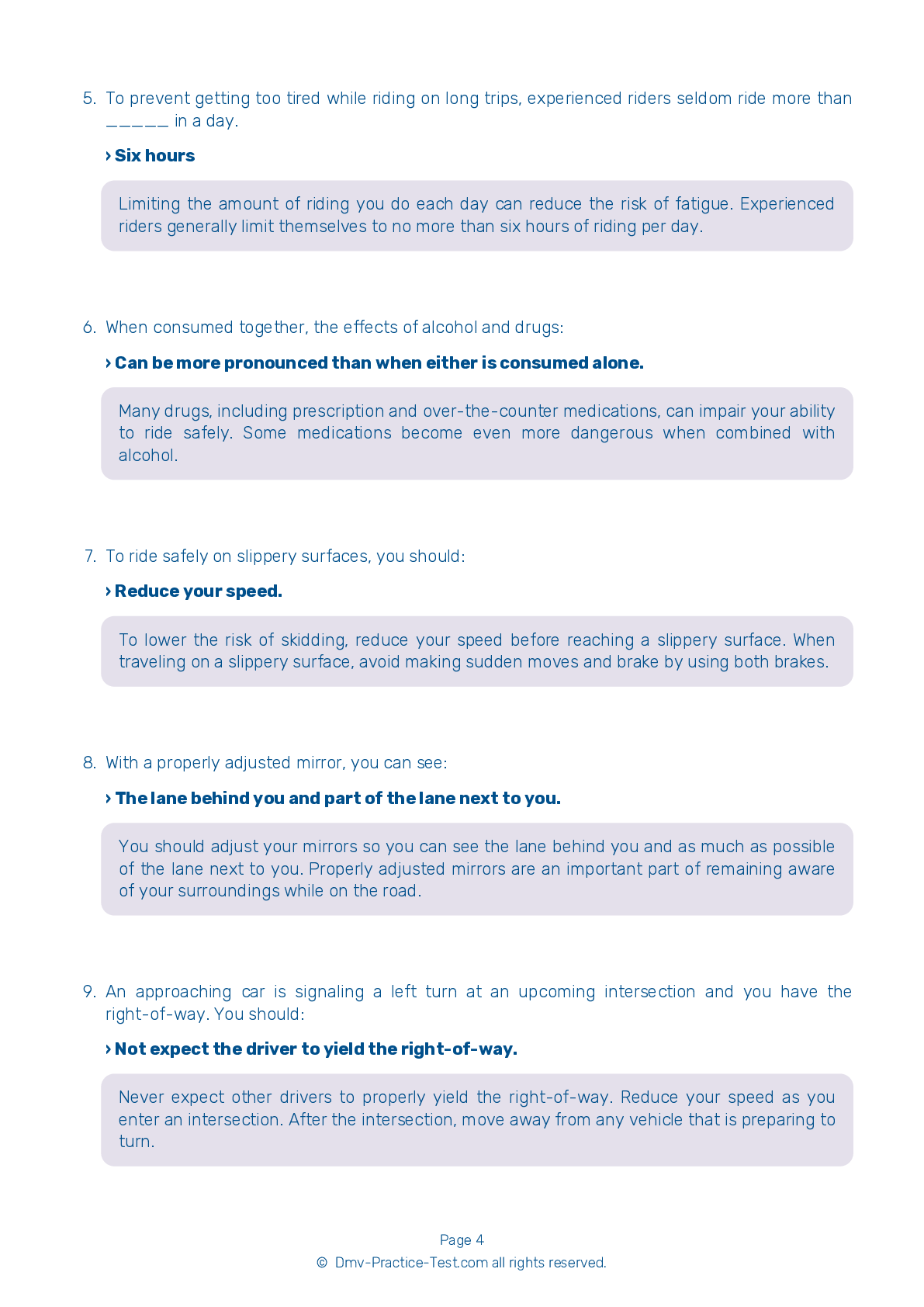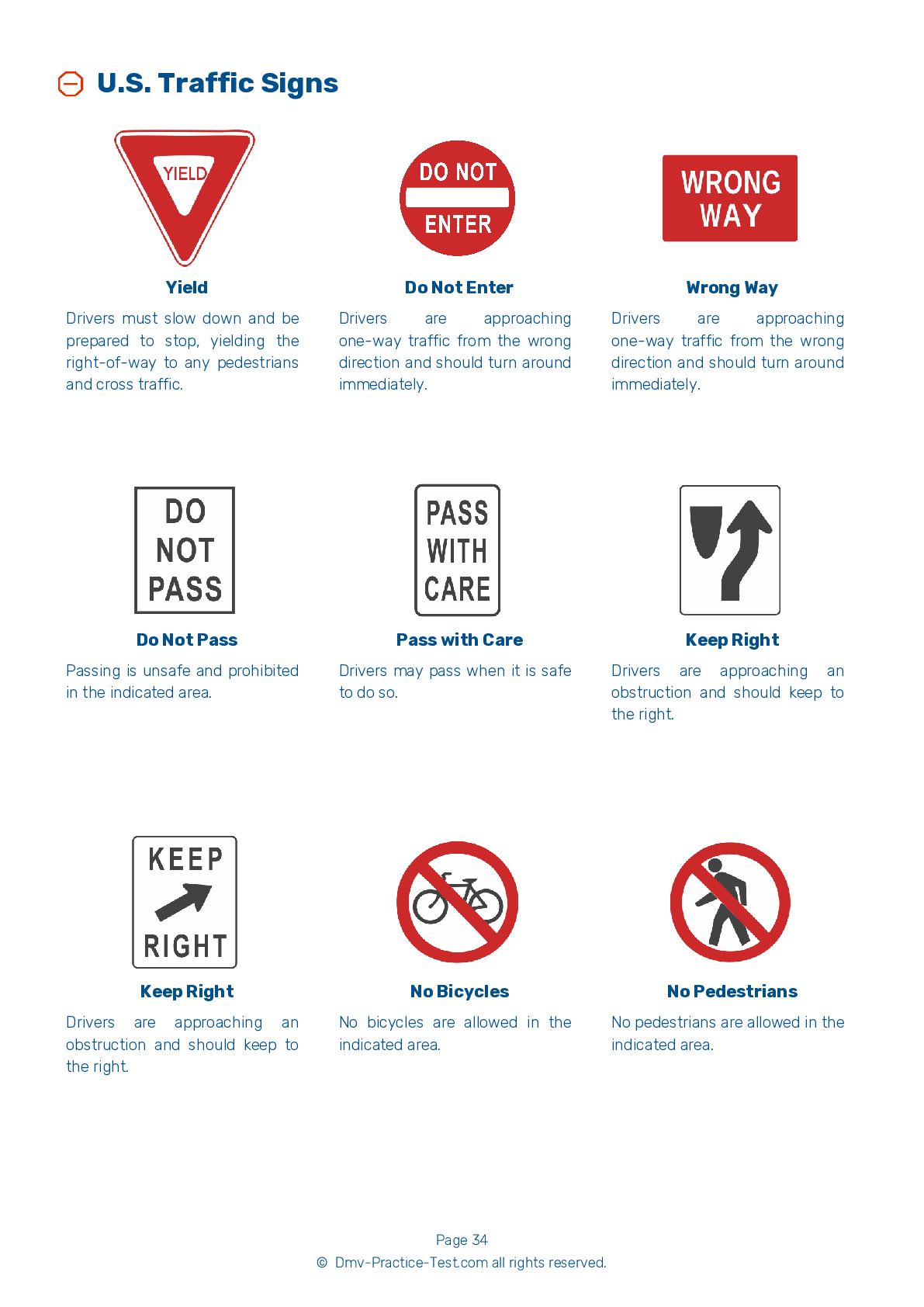DMV Permit Test #8
Motorcycle Test | License PA 2025 | FREE Online Practice! #8 Page 4 of 4
Take this FREE motorcycle test (license in PA 2025) to check your knowledge of the road rules. To improve your results, download a motorcycle handbook online, study theory, and practice for free on our website. Still worried about how to get a motorcycle license in Pennsylvania in 2025? Check our website for more sample tests, train as much as possible, and boost your grades!
20
16
16
16 . Your lane position should do all of the following, except:
Increase your ability to be seen by others.
A well-chosen lane position should increase your ability to see and be seen and keep you out of other drivers' blind spots. It should help you avoid surface hazards, protect your lane from other drivers, communicate your intentions to others, help you avoid wind blasts from other vehicles, and offer you an escape route from any hazards that may arise.
17 . When approaching a blind intersection, riders should:
Stop at the stop line then proceed through the intersection.
When approaching a blind intersection that is controlled by a stop line or stop sign, you must first stop where indicated. You may then edge forward and stop again just short of where the cross traffic lane meets your lane. From that position, lean your body forward and look around buildings, parked cars, or bushes to see if anything is approaching. Make sure your front wheel stays out of the crossroad while you are looking.
18 . What are the four steps to safely completing a turn?
Shift, lean, tuck, and roll.
To safely complete a turn, a rider should slow, look, press, and roll. The rider should reduce their speed when approaching the turn and look through the turn to where they want to go. They should press the handle grip in the direction of the turn and roll on the throttle through the turn to stabilize suspension.
19 . Make a special point of using your mirrors:
Before slowing or stopping.
You should make a special point of checking your mirrors when stopping at an intersection, before changing lanes, and when slowing down.
20 . Keeping a cushion of space around your motorcycle:
Makes you vulnerable.
Your first and best protection from any kind of hazard is simply to keep your distance. Maintaining a cushion of space on all sides of your motorcycle will give you time and space to maneuver around any danger that arises.
Need Motorcycle Insurance? No problem!
Compare the best rates in Pennsylvania and find a personalized policy that meets your needs.
1. Are You Currently insured ?
2. Married ?
3. Do you own your Home?
4. Have you or a Family Member Honorably Served in U.S. Military ?
5. Your Name
6. Age
7. Zip code
Ranked by best match
2025 Pennsylvania | Frequently Asked Questions
To acquire a motorcycle driver's license in Pennsylvania, you must first apply for a motorcycle learner's permit at a PennDOT Driver License Center. After practicing, you can schedule a road test. If you're under 18, you must have your permit for at least 6 months and complete a PennDOT-approved motorcycle safety course before taking the road test.
In Pennsylvania, the minimum age to obtain a motorcycle driver's license is 16 years old. However, if you are under 18 years old, you must first obtain a motorcycle learner's permit and maintain it for a minimum of six months. Additionally, parental consent is required for applicants under 18.
Yes, in Pennsylvania, you need a dedicated motorcycle license, known as Class M license, to legally operate a motorcycle. You can obtain this by passing a written test and on-cycle skills test. Alternatively, if you complete a Pennsylvania Motorcycle Safety Program Beginner Riding Clinic, the skills test may be waived.
To apply for a motorcycle driver's license in Pennsylvania, you need a completed application form DL-180 (Non-Commercial Learner's Permit Application), proof of identity (like a birth certificate or passport), two proofs of residency (such as utility bills or lease agreement), your Social Security card, and the appropriate fee. If you're under 18, you'll also need a Parent or Guardian Consent Form (DL-180TD).
Yes, you will need to take a written exam for a motorcycle license in Pennsylvania. The test covers topics such as basic motorcycle knowledge, road rules, safe riding techniques, and how to handle hazardous situations. The information for the test comes from the Pennsylvania Motorcycle Operator Manual.
The written test for a motorcycle license in Pennsylvania covers a variety of subjects related to motorcycle operation and safety. Topics include road rules specific to motorcycles, safe riding techniques, handling dangerous surfaces, carrying passengers or cargo, group riding, avoiding collisions, and dealing with mechanical problems. The test is based on information found in the PA Motorcycle Operator Manual.
No, the motorcycle training course in Pennsylvania doesn't substitute the written test. The course offers practical training and ends with a skills test. However, you still need to pass a written test to get your motorcycle permit before you can take the training course or the road test for your motorcycle license.
In Pennsylvania, you can enroll in a motorcycle training course through the Pennsylvania Motorcycle Safety Program (PAMSP). You can register online on their website. The courses are free to all Pennsylvania residents and active-duty military with a valid Pennsylvania driver's license and motorcycle permit. Classes are available for all skill levels.
No, you don't need to own a motorcycle for the license test in Pennsylvania. You can use any motorcycle that is properly registered, insured, and meets the state's safety requirements. However, you must have a valid permit and appropriate proof of insurance and registration for the motorcycle you plan to use.
Yes, you can use a friend's motorcycle for the license test in Pennsylvania, provided the motorcycle is legally registered and insured. It must also meet safety standards. Remember, you must have a valid motorcycle learner's permit to legally operate the motorcycle for the test.
Yes, in Pennsylvania, the motorcycle driving exam tests specific handling skills. These include the ability to balance, accelerate, decelerate, and turn both left and right. The exam also assesses the rider's skills in emergency stopping, evasive maneuvers, following traffic rules, and understanding road signs. It's essential to demonstrate control and safety throughout the test.
In Pennsylvania, new motorcycle drivers are required to obtain a motorcycle learner's permit before getting a motorcycle license. The permit has restrictions such as no riding after sunset or before sunrise, no carrying passengers, and no riding on public highways with a speed limit exceeding 50 mph.
Yes, your Pennsylvania motorcycle license is valid across the United States due to interstate compact agreements. However, you must adhere to the traffic laws of the state you are in, which may differ from Pennsylvania's. Always familiarize yourself with local laws when riding out of state.
In Pennsylvania, motorcycle operators and passengers are required to wear a helmet unless they are 21 years or older and have either two years of riding experience or have completed a motorcycle safety course approved by PennDOT or the Motorcycle Safety Foundation.
Yes, Pennsylvania offers two types of motorcycle licenses: M and L. An 'M' license allows you to operate any motorcycle, while an 'L' license limits you to motor-driven cycles only. You can upgrade from an 'L' to an 'M' license by passing the skills test on a larger motorcycle.
Yes, in Pennsylvania, you can add supplementary endorsements to your motorcycle license. For instance, you can add a "3" endorsement to your driver's license to operate a motorcycle. However, you must pass a knowledge test and on-cycle skills test to get the endorsement. Always check with the Pennsylvania Department of Transportation for any changes or updates.
Yes, the Pennsylvania Department of Transportation offers the motorcycle license test in several languages other than English. These include Spanish, Chinese, Russian, and Vietnamese among others. It's recommended to contact your local DMV office to confirm language availability before scheduling your test.
An effective strategy to prepare for the motorcycle license test in Pennsylvania includes studying the Pennsylvania Motorcycle Operator Manual thoroughly, taking practice tests to familiarize yourself with the format and types of questions, and enrolling in a motorcycle safety program. This combination of theoretical knowledge and practical skills training can greatly enhance your chances of passing the test.
Yes, the Pennsylvania Department of Transportation provides the motorcycle written exam in several languages other than English. These include Spanish, Chinese, Russian, and Vietnamese among others. However, it's advisable to check with your local DMV office for specific language availability before scheduling your exam.
Yes, retaking is allowed if you don't pass the motorcycle written test in Pennsylvania. After failing, you can retake the test after 7 days. However, if you fail three times, you must wait 6 months before attempting again. It's recommended to study the Pennsylvania Motorcycle Operator Manual thoroughly before retaking the test.



